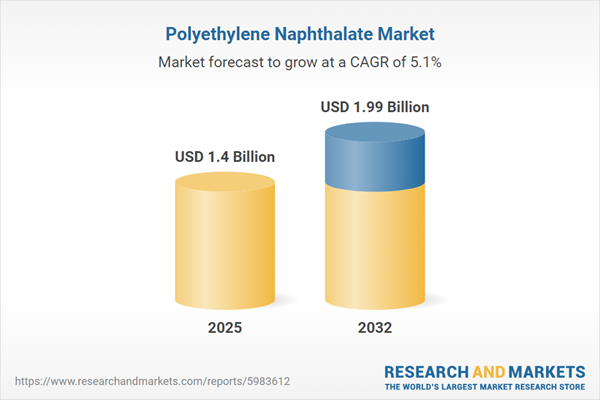Speak directly to the analyst to clarify any post sales queries you may have.
Polyethylene Naphthalate (PEN) is a high-performance polymer that continues to gain traction across industries requiring advanced barrier properties, durability, and sustainability credentials. As organizations pursue innovations in packaging, electronics, and technical textiles, PEN’s distinctive benefits position it to address evolving market and regulatory needs.
Market Snapshot: Polyethylene Naphthalate Market Growth and Investment Momentum
The Polyethylene Naphthalate market grew from USD 1.33 billion in 2024 to USD 1.40 billion in 2025, reflecting steady momentum. Projected to expand at a compound annual growth rate (CAGR) of 5.08%, the market is anticipated to reach USD 1.99 billion by 2032. This expansion is fueled by rising demand for advanced materials in premium packaging, automotive components, and electronics that require high barrier performance and chemical resistance.
Scope & Segmentation
This report delivers a comprehensive assessment of the Polyethylene Naphthalate market, segmenting key dimensions critical for decision-makers:
- Form — Bottle (including Carbonated Beverage, Juice, and Water Bottles), Fiber (Filament Yarn, Staple Fiber), Sheet Film (Biaxial Film, Cast Film, Extruded Sheet)
- Application — Bottles, Films (Biaxial, Cast), Trays
- End Use Industry — Automotive (Exteriors, Interiors), Electrical & Electronics (Capacitors, Insulators), Packaging (Cosmetic, Food, Medical Packaging)
- Grade — High Barrier Grade, Specialty (Heat Stabilized, UV Resistant), Standard Grade
- Manufacturing Process — Batch Polymerization, Continuous Polymerization
- Geographic Coverage — Americas (North America, Latin America), Europe, Middle East & Africa (Europe, Middle East, Africa), Asia-Pacific
- Company Analysis — Major stakeholders include Teijin Limited, SKC Co., Ltd., Mitsubishi Gas Chemical Company, Inc., Toray Industries, Inc., DuPont de Nemours, Inc., Kolon Industries, Inc., Far Eastern New Century Corporation, Chang Chun Petrochemical Co., Ltd., Tongkun Group Co., Ltd., and Zhejiang Huafon Chemical Co., Ltd.
Key Takeaways for Senior Decision-Makers
- Advanced material science is enabling new PEN applications in sectors ranging from packaging to high-end electronics, leveraging its mechanical and thermal performance.
- Ongoing R&D partnerships between chemical producers and end-users are fostering innovations such as bio-based feedstocks, enhanced UV resistance, and closed-loop recycling options.
- Manufacturers are integrating process digitalization, using real-time analytics and AI for predictive maintenance and yield optimization, leading to greater operational efficiency.
- Sustainability is increasingly central, with industry leaders focusing on reduced environmental footprint and circular economy models through renewable feedstocks and improved recyclability.
- Strategic alliances and regional production localization are emerging as effective responses to supply chain risk, tariff policy changes, and shifting regulatory landscapes.
Impact of US Tariff Regimes on Polyethylene Naphthalate Supply Chains
The introduction of new United States tariff regimes in 2025 is driving significant reassessment of sourcing and supply chain strategies. Domestic processors are accelerating investments in regional integration, often by cultivating closer partnerships with North American feedstock suppliers. Global manufacturers are leveraging free trade zones and bonded warehouses to manage costs, while smaller converters may seek alliances to weather increased margin pressures. Competitive dynamics are shifting, with alternative materials and value-engineering initiatives gaining priority in response to higher imported resin costs.
Methodology & Data Sources
This analysis is grounded in a robust blend of primary and secondary research. Structured interviews with stakeholders across the value chain provided firsthand insights into strategic priorities and evolving challenges. Desk research drew from technical journals, regulatory filings, and proprietary patent resources, while quantitative data was validated through triangulation and expert peer review. Assumptions related to tariffs, technology, and feedstock were rigorously tested through sensitivity analysis.
Why This Report Matters
- Enables executives to identify growth opportunities and risks across forms, grades, and industries with clear, actionable segmentation.
- Equips supply chain and R&D leaders with insights into tariff-driven shifts and innovation catalysts shaping the PEN landscape.
- Supports forward planning by combining current market intelligence with deep-dive analysis of emerging sustainability and digitalization strategies.
Conclusion
The Polyethylene Naphthalate market is undergoing a period of transformation, shaped by innovation, sustainability, and new regulatory realities. Stakeholders who adapt with agile supply chains and invest in collaborative development will be positioned for long-term advantage in premium material markets.
Additional Product Information:
- Purchase of this report includes 1 year online access with quarterly updates.
- This report can be updated on request. Please contact our Customer Experience team using the Ask a Question widget on our website.
Table of Contents
3. Executive Summary
4. Market Overview
7. Cumulative Impact of Artificial Intelligence 2025
Companies Mentioned
The companies profiled in this Polyethylene Naphthalate market report include:- Teijin Limited
- SKC Co., Ltd.
- Mitsubishi Gas Chemical Company, Inc.
- Toray Industries, Inc.
- DuPont de Nemours, Inc.
- Kolon Industries, Inc.
- Far Eastern New Century Corporation
- Chang Chun Petrochemical Co., Ltd.
- Tongkun Group Co., Ltd.
- Zhejiang Huafon Chemical Co., Ltd.
Table Information
| Report Attribute | Details |
|---|---|
| No. of Pages | 186 |
| Published | October 2025 |
| Forecast Period | 2025 - 2032 |
| Estimated Market Value ( USD | $ 1.4 Billion |
| Forecasted Market Value ( USD | $ 1.99 Billion |
| Compound Annual Growth Rate | 5.0% |
| Regions Covered | Global |
| No. of Companies Mentioned | 11 |









